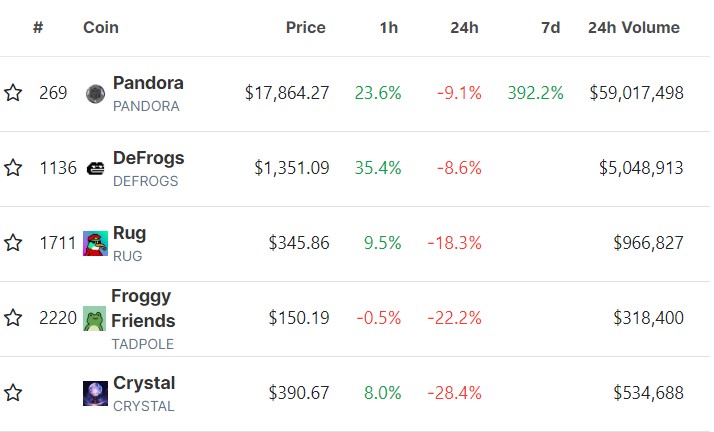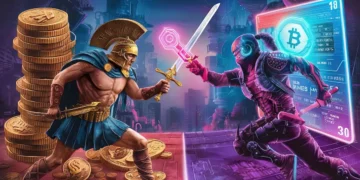Surprisingly, the newly introduced Ethereum (ETH) token standard, ERC-404, made an impressive debut in the crypto market, outperforming many other digital assets.
However, as Bitcoin (BTC), the dominant cryptocurrency, began to rally, investors swiftly shifted their focus to the king of crypto. Consequently, this shift led to notable price drops and market capitalization declines across the ERC-404 ecosystem and its associated tokens.
From Skyrocketing Surges To Sharp Corrections
According to data from CoinGecko, the ERC-404 sector has experienced a significant decline, with an overall market capitalization drop of 29% in the past 24 hours.
Key tokens within this sector, including PANDORA, DeFrogs, RUG, Froggy Friends, and Crystal, have all witnessed substantial price decreases. PANDORA, which had garnered attention and speculation, surged by a staggering 12,000% within a week.
Opening at $250 on February 3, 2024, its value skyrocketed to over $34,000 per token by February 9, 2024. However, it dropped by 38% from its all-time high (ATH) in just 24 hours.

On the other hand, Crystal suffered the most significant losses, with its price plummeting by 28.4% and trading volume declining by over 35%. These figures indicate a stark decline in market activity for the token. Currently, Crystal is down more than 51% from its ATH of $792.74, exemplifying the inherent volatility of the ERC-404 sector.
Following closely behind, Froggy Friends experienced a 16% drop in trading volume and an 81% decrease in price from its peak of $823. CoinGecko data reveals that Froggy Friends currently trades at $150 per token.
But what are the ERC-404 token standards? And what is causing the price and market capitalization to drop?
Navigating The ERC-404 Ecosystem
Ethereum, known for its smart contract platform, has been a breeding ground for various token standards. While ERC-20 and ERC-721 gained widespread adoption for fungible and non-fungible tokens (NFTs), a new contender emerged: ERC-404.
Named after the popular website error code “404,” ERC-404 introduces the concept of “semi-fungibility” to Ethereum. It combines the divisibility of ERC-20 tokens with the uniqueness of ERC-721 tokens, bridging the gap between these two types.
ERC-404 tokens are associated with specific NFTs, allowing fractional transfers of linked NFTs. Full ownership results in minting the linked NFT to the holder’s wallet, while fractional transfers trigger the burning of the associated NFT. New NFTs are automatically minted when sufficient fractions are accumulated to form a complete token.
DN-404 Prepares To Challenge ERC-404’s Dominance?
According to a recent report by The Block, transaction fees increased as ERC-404 tokens gained traction, prompting developers to work on an alternative implementation called Divisible NFT (DN-404).
This new standard aims to optimize code and reduce transaction fees, addressing the rising costs associated with ERC-404 tokens. The DN-404 implementation is set to be released soon, potentially alleviating network congestion caused by the influx of ERC-404 tokens.
While there were initial discussions between the Pandora team, the creators of ERC-404, and the developers working on DN-404, the two groups did not reach an agreement and are not collaborating, according to the report.
This introduces uncertainty for traders and investors who navigate between supporting the original ERC-404 or the upcoming DN-404 implementation.
Overall, the introduction of ERC-404 brought excitement and volatility to the crypto market. While semi-fungibility and fractional transfers of linked NFTs hold promise, challenges such as rising transaction fees and the emergence of DN-404 have impacted the ERC-404 ecosystem.
Traders and investors now face the dilemma of choosing between the original implementation and the upcoming alternative. As the market evolves, it will be interesting to see how the ERC-404 sector adapts and whether it can regain stability and investor confidence.
Featured image from Shutterstock, chart from TradingView.com
Disclaimer: The article is provided for educational purposes only. It does not represent the opinions of NewsBTC on whether to buy, sell or hold any investments and naturally investing carries risks. You are advised to conduct your own research before making any investment decisions. Use information provided on this website entirely at your own risk.
Surprisingly, the newly introduced Ethereum (ETH) token standard, ERC-404, made an impressive debut in the crypto market, outperforming many other digital assets.
However, as Bitcoin (BTC), the dominant cryptocurrency, began to rally, investors swiftly shifted their focus to the king of crypto. Consequently, this shift led to notable price drops and market capitalization declines across the ERC-404 ecosystem and its associated tokens.
From Skyrocketing Surges To Sharp Corrections
According to data from CoinGecko, the ERC-404 sector has experienced a significant decline, with an overall market capitalization drop of 29% in the past 24 hours.
Key tokens within this sector, including PANDORA, DeFrogs, RUG, Froggy Friends, and Crystal, have all witnessed substantial price decreases. PANDORA, which had garnered attention and speculation, surged by a staggering 12,000% within a week.
Opening at $250 on February 3, 2024, its value skyrocketed to over $34,000 per token by February 9, 2024. However, it dropped by 38% from its all-time high (ATH) in just 24 hours.

On the other hand, Crystal suffered the most significant losses, with its price plummeting by 28.4% and trading volume declining by over 35%. These figures indicate a stark decline in market activity for the token. Currently, Crystal is down more than 51% from its ATH of $792.74, exemplifying the inherent volatility of the ERC-404 sector.
Following closely behind, Froggy Friends experienced a 16% drop in trading volume and an 81% decrease in price from its peak of $823. CoinGecko data reveals that Froggy Friends currently trades at $150 per token.
But what are the ERC-404 token standards? And what is causing the price and market capitalization to drop?
Navigating The ERC-404 Ecosystem
Ethereum, known for its smart contract platform, has been a breeding ground for various token standards. While ERC-20 and ERC-721 gained widespread adoption for fungible and non-fungible tokens (NFTs), a new contender emerged: ERC-404.
Named after the popular website error code “404,” ERC-404 introduces the concept of “semi-fungibility” to Ethereum. It combines the divisibility of ERC-20 tokens with the uniqueness of ERC-721 tokens, bridging the gap between these two types.
ERC-404 tokens are associated with specific NFTs, allowing fractional transfers of linked NFTs. Full ownership results in minting the linked NFT to the holder’s wallet, while fractional transfers trigger the burning of the associated NFT. New NFTs are automatically minted when sufficient fractions are accumulated to form a complete token.
DN-404 Prepares To Challenge ERC-404’s Dominance?
According to a recent report by The Block, transaction fees increased as ERC-404 tokens gained traction, prompting developers to work on an alternative implementation called Divisible NFT (DN-404).
This new standard aims to optimize code and reduce transaction fees, addressing the rising costs associated with ERC-404 tokens. The DN-404 implementation is set to be released soon, potentially alleviating network congestion caused by the influx of ERC-404 tokens.
While there were initial discussions between the Pandora team, the creators of ERC-404, and the developers working on DN-404, the two groups did not reach an agreement and are not collaborating, according to the report.
This introduces uncertainty for traders and investors who navigate between supporting the original ERC-404 or the upcoming DN-404 implementation.
Overall, the introduction of ERC-404 brought excitement and volatility to the crypto market. While semi-fungibility and fractional transfers of linked NFTs hold promise, challenges such as rising transaction fees and the emergence of DN-404 have impacted the ERC-404 ecosystem.
Traders and investors now face the dilemma of choosing between the original implementation and the upcoming alternative. As the market evolves, it will be interesting to see how the ERC-404 sector adapts and whether it can regain stability and investor confidence.
Featured image from Shutterstock, chart from TradingView.com
Disclaimer: The article is provided for educational purposes only. It does not represent the opinions of NewsBTC on whether to buy, sell or hold any investments and naturally investing carries risks. You are advised to conduct your own research before making any investment decisions. Use information provided on this website entirely at your own risk.


















































































can i get clomid without rx get clomiphene for sale get generic clomid for sale cost generic clomiphene without a prescription order cheap clomiphene without dr prescription where to get generic clomiphene without prescription cost clomiphene prices
Good blog you procure here.. It’s obdurate to espy great status article like yours these days. I really recognize individuals like you! Rent care!!
I am in truth happy to coup d’oeil at this blog posts which consists of tons of useful facts, thanks object of providing such data.
cost azithromycin 500mg – order tetracycline without prescription how to buy flagyl
semaglutide for sale – order cyproheptadine 4mg pill cyproheptadine 4 mg price
order motilium 10mg generic – order tetracycline generic order cyclobenzaprine generic
buy augmentin 1000mg sale – https://atbioinfo.com/ purchase ampicillin sale
buy generic nexium for sale – anexa mate nexium online buy
order warfarin 5mg – https://coumamide.com/ order cozaar 50mg online cheap
order meloxicam – mobo sin mobic order
buy deltasone 10mg generic – https://apreplson.com/ prednisone 10mg usa
buy ed pills no prescription – site home remedies for ed erectile dysfunction
order amoxicillin online cheap – amoxil generic buy amoxil sale
buy diflucan without a prescription – https://gpdifluca.com/# diflucan where to buy
oral cenforce 50mg – https://cenforcers.com/# cenforce brand
cialis and adderall – buy cialis on line tadalafil tablets 20 mg side effects
buy zantac 300mg sale – https://aranitidine.com/# order ranitidine 150mg generic
order viagra pills – order viagra toronto viagra buy japan
Thanks on putting this up. It’s well done. https://gnolvade.com/
With thanks. Loads of expertise! https://buyfastonl.com/azithromycin.html
More posts like this would bring about the blogosphere more useful. https://ursxdol.com/cialis-tadalafil-20/
This is the compassionate of literature I in fact appreciate. https://prohnrg.com/
This is a topic which is in to my verve… Myriad thanks! Exactly where can I find the phone details for questions? https://aranitidine.com/fr/ivermectine-en-france/
This is the make of advise I find helpful. https://ondactone.com/product/domperidone/
This is the kind of literature I truly appreciate.
https://doxycyclinege.com/pro/ondansetron/
More content pieces like this would make the интернет better. http://bbs.yongrenqianyou.com/home.php?mod=space&uid=4271944&do=profile
order forxiga generic – order dapagliflozin 10 mg online cheap cost forxiga 10mg
xenical online – janozin.com buy orlistat 60mg online
More posts like this would prosper the blogosphere more useful. http://www.underworldralinwood.ca/forums/member.php?action=profile&uid=493536